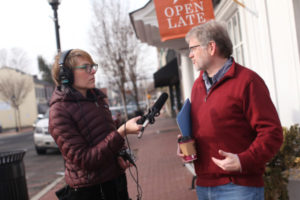At the University of Mary Washington, geography majors don’t just learn in the classroom. They actually DO geography.

Professor of Geography Steve Hanna, seen here during a 2018 interview for ‘With Good Reason’ radio, is the co-author of a new book, ‘Remembering Enslavement: Reassembling the Southern Plantation Museum,’ released by University of Georgia Press earlier this week. Photo by Karen Pearlman.
It’s a pride point for Professor Steve Hanna, who began teaching at Mary Washington a quarter century ago, drawn here because of his strong belief in the value of a public liberal arts education, with lots of hands-on learning opportunities.
“Our classes get students out into the world – both virtually and physically – where they explore cultural landscapes and collect data about the natural environment and the people who live there,” said Hanna, who earned his own degrees from Massachusetts’ Clark University and the universities of Vermont and Kentucky.
Almost a decade ago, Hanna and faculty collaborators from across the country received a three-year National Science Foundation grant to study – and hopefully change – how Southern plantations tell the story of enslaved people. Together, they’ve published a new book, Remembering Enslavement: Reassembling the Southern Plantation Museum, released by University of Georgia Press earlier this week.

Hanna’s new book, co-authored with colleagues across the country, based on years of research he conducted with faculty collaborators and his students.
The group’s sole cartographer, Hanna and his colleagues did narrative mapping at 15 antebellum museums in Louisiana, South Carolina and Virginia. Eight of his students – now UMW alums – were there every step of the way, capturing and interpreting tours, and surveying visitors at each site.
“As a country, we unfortunately have a racial history that has excluded major parts of the narrative at these museums and other commemorative sites,” said Hanna, who was awarded UMW’s Waple Professorship in 2016 for his work. “Mapping suggests new ways these stories can be told,” he added.
Their findings were featured in a Journal of Heritage Tourism article, which won Hanna and his collaborators the prestigious Zumkehr Prize for Scholarship in Public Memory.
The research also attracted the attention of staff at Montpelier, home to James Madison. Before COVID hit, Hanna and another set of UMW students studied the Virginia presidential plantation and three others: Mount Vernon, Monticello and Highland. They shared their results and recommendations on how each site could better incorporate stories about slavery into their exhibits and tours.
“We found that visitors not only said they learned more about enslaved people when they were included in the narrative,” Hanna said, “but that they also felt more empathy toward them.”
Q: What do you tell students who are considering majoring in geography at UMW?
A: You’ll develop marketable skills in mapping, geospatial analysis, remote sensing, and qualitative and quantitative research. Our alums have excelled in careers in planning, geographic information systems, teaching and more. Many also earn our Master of Science in Geospatial Analysis degree – and we’re adding an undergraduate major in that area next year.
Q: What’s your favorite thing in your office?
A: A photo of me with three of my research students.
Q: What do you enjoy doing outside of work?
A: Sailing, walking around downtown Fredericksburg and dining at local restaurants.
Q: What would people be surprised to learn about you?
A: I’m a member of the handbell choir at the Unitarian Universalist Fellowship of Fredericksburg.
Q: What do you like best about the UMW campus?
A: The fountain in front of Monroe Hall, which is labeled “The Fountain of Greatness” on Google Maps.